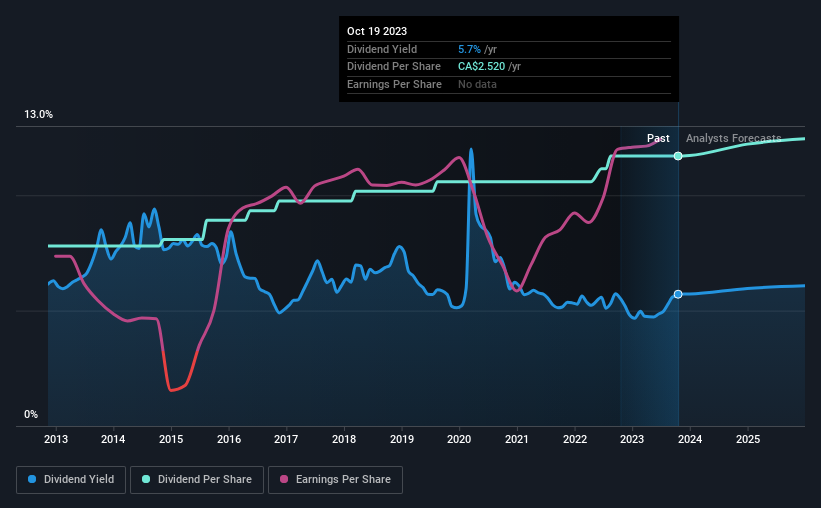
The board of Exchange Income Corporation (TSE:EIF) has announced that it will pay a dividend on the 15th of November, with investors receiving CA$0.21 per share. This means the annual payment is 5.7% of the current stock price, which is above the average for the industry.
View our latest analysis for Exchange Income
Exchange Income's Dividend Is Well Covered By Earnings
A big dividend yield for a few years doesn't mean much if it can't be sustained. Before making this announcement, Exchange Income was paying out a fairly large proportion of earnings, and it wasn't generating positive free cash flows either. Generally, we think that this would be a risky long term practice.
Over the next year, EPS is forecast to expand by 30.1%. Assuming the dividend continues along recent trends, our estimates say the payout ratio could reach 79% - on the higher side, but we wouldn't necessarily say this is unsustainable.

Exchange Income Has A Solid Track Record
The company has been paying a dividend for a long time, and it has been quite stable which gives us confidence in the future dividend potential. The annual payment during the last 10 years was CA$1.68 in 2013, and the most recent fiscal year payment was CA$2.52. This implies that the company grew its distributions at a yearly rate of about 4.1% over that duration. Slow and steady dividend growth might not sound that exciting, but dividends have been stable for ten years, which we think makes this a fairly attractive offer.
Exchange Income May Find It Hard To Grow The Dividend
Investors who have held shares in the company for the past few years will be happy with the dividend income they have received. However, Exchange Income has only grown its earnings per share at 2.9% per annum over the past five years. Slow growth and a high payout ratio could mean that Exchange Income has maxed out the amount that it has been able to pay to shareholders. That's fine as far as it goes, but we're less enthusiastic as this often signals that the dividend is likely to grow slower in the future.
We should note that Exchange Income has issued stock equal to 11% of shares outstanding. Regularly doing this can be detrimental - it's hard to grow dividends per share when new shares are regularly being created.
Exchange Income's Dividend Doesn't Look Sustainable
Overall, it's nice to see a consistent dividend payment, but we think that longer term, the current level of payment might be unsustainable. We can't deny that the payments have been very stable, but we are a little bit worried about the very high payout ratio. We would probably look elsewhere for an income investment.
Market movements attest to how highly valued a consistent dividend policy is compared to one which is more unpredictable. Still, investors need to consider a host of other factors, apart from dividend payments, when analysing a company. Case in point: We've spotted 3 warning signs for Exchange Income (of which 1 can't be ignored!) you should know about. Looking for more high-yielding dividend ideas? Try our collection of strong dividend payers.
Valuation is complex, but we're here to simplify it.
Discover if Exchange Income might be undervalued or overvalued with our detailed analysis, featuring fair value estimates, potential risks, dividends, insider trades, and its financial condition.
Access Free AnalysisHave feedback on this article? Concerned about the content? Get in touch with us directly. Alternatively, email editorial-team (at) simplywallst.com.
This article by Simply Wall St is general in nature. We provide commentary based on historical data and analyst forecasts only using an unbiased methodology and our articles are not intended to be financial advice. It does not constitute a recommendation to buy or sell any stock, and does not take account of your objectives, or your financial situation. We aim to bring you long-term focused analysis driven by fundamental data. Note that our analysis may not factor in the latest price-sensitive company announcements or qualitative material. Simply Wall St has no position in any stocks mentioned.
About TSX:EIF
Exchange Income
Engages in aerospace and aviation services and equipment, and manufacturing businesses worldwide.
Reasonable growth potential and fair value.
Market Insights
Community Narratives




